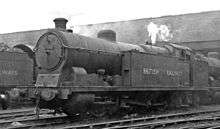Mexborough engine shed

Mexborough engine shed was an engine shed in Swinton, in South Yorkshire, England. It was built by the Great Central Railway. The shed was built slightly to the west of the current Mexborough station on land between the River Don and the River Don Navigation. It had 15 dead end roads, and could handle about 150 steam locomotives, mainly for use on freight trains. The London and North Eastern Railway operated the shed from 1923. In 1948, on the formation of British Railways Eastern Region, Mexborough bore the shed code 36B, then 41F from 1958. It closed in February 1964.
Most of the locomotives stabled at Mexborough were used for hauling coal trains. The coal originated from the many collieries in the South Yorkshire coalfield and wagons of coal were despatched to locations all over the country. However, the main destinations were the industries and power stations in Lancashire. With the opening of the Wath marshalling yard in 1907, Mexborough supplied locomotives for collecting wagons from the collieries, for re-marshalling of the wagons at Wath and for hauling coal trains across the steeply-graded "Woodhead" route across the Pennines into Lancashire. In the 1920s, the depot was the stabling point for what was then the most powerful locomotive in the UK, the London & North Eastern Railway's Garratt. It was used for banking heavy coal trains up the Worsborough incline on the Woodhead route.[1]
In the 1950s, the route from Wath to Manchester was electrified. Consequently, the demand for the steam locomotives from the Mexborough depot reduced. The electric locomotives were stabled at Wath rather than Mexborough. Even the steam shunting engines for the marshalling work at Wath yard were replaced by diesel shunters in 1957.[2] The use of steam locomotives for collecting coal from local collieries was also phased out and the depot closed in 1964. The site of Mexborough depot is now occupied by units in an industrial estate off of Meadow Way in Swinton. In its heyday, the depot had its own football team, Mexborough Locomotive Works F.C..
Locomotives
On 1 January 1923 the following classes of locomotive were allocated to Mexborough.[3]
| GCR class | LNER Class | Wheel Arrangement | No. allocated | Remarks[4] |
|---|---|---|---|---|
| GCR Class 8 | B5 | 4-6-0 | 7 | Initially built for fast fish traffic and known as “Fish Engines” |
| GCR Class 9K | C13 | 4-4-2T | 2 | Worked local passenger services |
| GCR Classes 2 & 2A | D7 | 4-4-0 | 6 | Worked local/medium distance passenger services |
| GCR Classes 11B, 11C, & 11D | D9 | 4-4-0 | 1 | Worked local/medium distance passenger services |
| GCR Classes 9D, 9H & 9M | J10 | 0-6-0 | 3 | Freight locomotives |
| GCR Class 9J | J11 | 0-6-0 | 2 | Freight locomotives |
| GCR Class 6C | J12 | 0-6-0 | 27 | Freight locomotives – occasionally used on excursions |
| GCR Class 9 | J13 | 0-6-0 | 5 | Freight locomotives |
| GCR Class 18T Altered | J59 | 0-6-0 T | 4 | Yard shunting engines nicknamed Humpies. |
| GCR Class 9A & 9A Altered | N4 | 0-6-2T | 1 | Shunting and trip engines |
| GCR Class 9C, 9F, & 9O | N5 | 0-6-2T | 15 | Shunting and trip engines |
| GCR Class 8K | O4 | 2-8-0 | 51 | Freight locomotives |
| GCR Class 8M | O5 | 2-8-0 | 6 | Freight locomotives |
| GCR Class 8A | Q4 | 0-8-0 | 36 | Freight locomotives |
| GCR Class 8H | S1 | 0-8-4T | 4 | This was the entire class although the LNER built two more in the 1930s. Used for shunting in Wath marshalling yard. |

In 1950, locomotive classes allocated to Mexborough included:[5]
- LNER Thompson Class B1 4-6-0
- LNER Class O2 2-8-0
- LNER Class J11 0-6-0
- LNER Class J50 0-6-0T
- LNER Class N5 0-6-2T
- WD Austerity 2-8-0
References
- Notes
- ↑ Jackson, David (1983). The Great Central in LNER Days. Ian Allan Ltd. ISBN 0711012717.
- ↑ "Shunting Loco at Mexborough". Geograph. Retrieved 9 August 2015.
- ↑ Yeadon, W B (1996). LNER Locomotive allocations 1 January 1923. Oldham: Challenger Publications. p. 38. ISBN 1-899624-19-8.
- ↑ "LNER encyclopedia - Locomotives". LNER ENCYCLOPEDIA. Retrieved 8 August 2016.
- ↑ Allan 1972, pp. 8–36
- Bibliography
- Allan, Ian (1972), British Railways Locomotive 1948-50, Ian Allan Ltd, ISBN 0-7110-0401-3
Coordinates: 53°29′29″N 1°17′22″W / 53.4914°N 1.2894°W